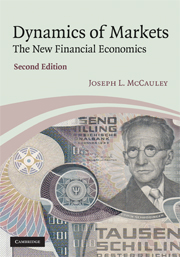Book contents
- Frontmatter
- Contents
- Preface to the second edition
- 1 Econophysics: why and what
- 2 Neo-classical economic theory
- 3 Probability and stochastic processes
- 4 Introduction to financial economics
- 5 Introduction to portfolio selection theory
- 6 Scaling, pair correlations, and conditional densities
- 7 Statistical ensembles: deducing dynamics from time series
- 8 Martingale option pricing
- 9 FX market globalization: evolution of the Dollar to worldwide reserve currency
- 10 Macroeconomics and econometrics: regression models vs empirically based modeling
- 11 Complexity
- References
- Index
4 - Introduction to financial economics
Published online by Cambridge University Press: 02 December 2010
- Frontmatter
- Contents
- Preface to the second edition
- 1 Econophysics: why and what
- 2 Neo-classical economic theory
- 3 Probability and stochastic processes
- 4 Introduction to financial economics
- 5 Introduction to portfolio selection theory
- 6 Scaling, pair correlations, and conditional densities
- 7 Statistical ensembles: deducing dynamics from time series
- 8 Martingale option pricing
- 9 FX market globalization: evolution of the Dollar to worldwide reserve currency
- 10 Macroeconomics and econometrics: regression models vs empirically based modeling
- 11 Complexity
- References
- Index
Summary
We will begin with several standard ideas from finance: no-arbitrage, the time value of money, and the Modigliani–Miller theorem, and then will introduce the newer concepts of liquidity and reversible trading, market instability, value in uncertain markets, and Black's idea of noise traders. More fundamentally, we'll formulate the efficient market hypothesis (EMH) as a Martingale condition, reflecting a hard-to-beat market. We'll also formulate hypothetical stationary markets, and show that stationary markets and efficient markets are mutually exclusive. A dynamic generalization of the neo-classical notion of value to real, nonstationary markets is presented. We will rely heavily on our knowledge of stochastic processes presented in Chapter 3. Orientation in finance market history is provided in the books by Bernstein (1992), Lewis (1989), Dunbar (2000), and Eichengreen (1996).
What does no-arbitrage mean?
The basic idea of horse trading is to buy a nag cheap and unload it on someone else for a profit. An analog of horse trading occurs in financial markets, where it's called “arbitrage.” The French word sounds more respectable than the Germanic phrase, especially to academics and bankers.
The idea of arbitrage is simple. If gold sells for $1001 in Dubai and for $989 in New York, then traders should tend to sell gold short in Dubai and simultaneously buy it in New York, assuming that transaction costs and taxes are less than the total gain (taxes and transaction costs are ignored to zeroth order in theoretical finance arguments). This brings us to two points.
- Type
- Chapter
- Information
- Dynamics of MarketsThe New Financial Economics, pp. 80 - 106Publisher: Cambridge University PressPrint publication year: 2009



